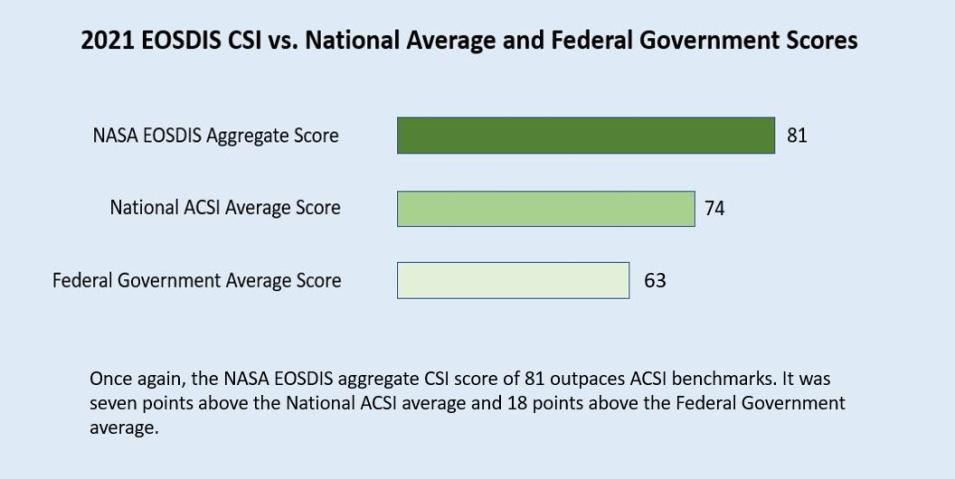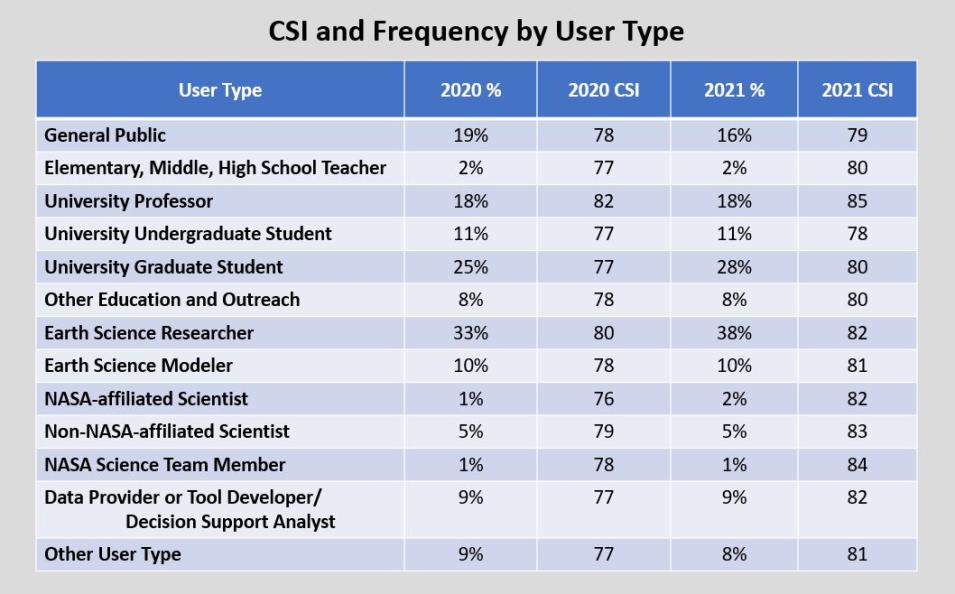To arrive at satisfaction score, the model uses a set of causal equations linking customer expectations, perceived quality, and perceived value to customer satisfaction to calculate a CSI score. Satisfaction, in turn, is further linked to a customer’s likelihood to recommend products and services and their willingness to use products and services in the future.
Two expected outcomes of high customer satisfaction with an agency’s services are trust and loyalty. This is accounted for in the ACSI algorithm and reflected by a number indicating the likelihood of a respondent to recommend the evaluated products and services to others coupled with the likelihood of a respondent to use the services in the future.
NASA EOSDIS’s CSI score of 81 indicates a high level of satisfaction with its products and services, and given that the CSI score is an aggregate of several scores (calculated using the proprietary ACSI methodology), scores in the upper-70s represent a “strong” performance, especially when maintained over several years. Likewise, increases in CSI scores of just a few points can denote a significant increase in user satisfaction.
NASA’s EOSDIS has never received a CSI score lower than 74 since the first EOSDIS ACSI survey was conducted in 2004. As with all previous surveys spanning more than 17 years, NASA’s EOSDIS outscored the federal government, which received an average score of 63 in 2021. In addition, CSI scores for EOSDIS DAACs ranged from 86 to 76, with an average aggregate CSI of 80.
The results from the annual ACSI survey provide something of a blueprint that the DAACs and NASA’s Earth Science Data and Information System (ESDIS) Project (which manages EOSDIS science operations, including data archival and distribution) can use to tailor their products and services so they better align with and serve user needs.
The score pertaining to respondents’ “likelihood to recommend EOSDIS products and services” — 89 out of 100 — was two points higher than in the 2020 survey. The score pertaining to respondents’ “likelihood to use EOSDIS services in the future” — 89 out of 100 — was one point higher than in the 2020 survey. These scores were three and two points higher, respectively, than those of the 2019 survey. These consistent rankings suggest that, over the years, EOSDIS has consistently provided products and services its users value.
The 2021 survey was conducted online between September 18 and October 20, 2021. Of the 183,646 survey invitations sent out, 6,337 completed surveys were returned in the 2021 for a response rate of 3.4%. By compassion, 758,000 survey invitations were sent out in 2020, resulting in 9,178 completed surveys for a response rate of 1.2%.
ESDIS, which coordinates and facilitates the annual ACSI survey, opted to use an abridged or “short-form” version of the survey questionnaire in 2021. The short form version of the survey was created to introduce some variation into this annual accounting of EOSDIS products and services and prevent any survey fatigue among respondents while continuing the more than 20-year record of results. As you might expect, the short form has fewer questions and takes less time to complete (i.e., approximately 5 minutes vs. 15-20 minutes) than the longer survey, but it focuses on DAAC-specific questions, which afford the DAACs greater insights. In the longer survey, these questions could be given short shrift given that they come after the initial first part of the survey, which is quite thorough.
The ESDIS Project began alternating short-form surveys with more detailed longer surveys as a way to maintain continuity with questions. So, whereas the 2020 survey used the long-form questionnaire, the 2021 survey used the short-form. Next year, EOSDIS will return to the long-form survey and so on.
Outside of three survey questions asking respondents to rate their overall expectations, perceived quality, and perceived value of EOSDIS services and products on a 1 to 10 scale, the survey asked respondents to evaluate their experience with the specific DAAC or DAACs from which they receive data and products. (Note: respondents were allowed to skip questions pertaining to DAACs they did not consult with or contact). The survey also allowed respondents to provide open-ended comments, providing EOSDIS with direct and valuable insights regarding respondents’ likes, dislikes, and thoughts on suggested improvements. These user comments are one of the most valuable aspects of the survey, as DAAC managers can use them to assess user needs and can look across DAACs to gain insight into user preferences and best practices.
In the following summary tables, total percentages may not equal 100% due to survey questions allowing for multiple responses; all non-percentage values are out of 100.



